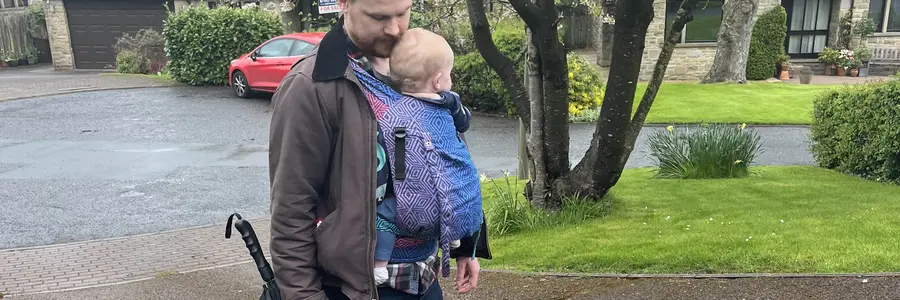What is baby carrying (or baby wearing)?
Humans are carry mammals, which means we are designed to hold our young in close proximity. When using a baby carrier of any kind, we aim to mimic how we carry babies naturally in our arms. We know that babies have touch needs and what better way to meet them than snuggling up in a way that leaves you hands-free? Not only does baby carrying improve bonding and boost oxytocin, but it also reduces crying.
How can physics help us with baby carrying?
When lifting an object, we know that work done (amount of energy transferred to an object) is equal to the force it takes to lift the object, multiplied by the distance the object is moved. Lifting something at an angle also contributes to this work load.
This can be written as W = Fd cos θ but don’t worry about this equation too much, put simply: we know holding a baby close to our body feels much easier than holding them further away from us.
Additionally, baby positioning contributes to a comfortable carry for both the adult and baby. Centre of gravity is important in any type of carrying; defined as the point in the body at which the total mass is concentrated. When you are standing up, this is roughly an inch below the belly button but centre of gravity shifts as you move and do different activities. We know that having a baby’s centre of gravity close to ours makes carrying easier and we can encourage this using natural shapes. Babies have an instinct when picked up to lift and grip their limbs in preparation for being carried. For a hip healthy position, we are aiming for infants to be naturally seated in a spread squat position, with support from knee to knee. This position not only supports the infant spine but also helps to decrease the distance between the centres of gravity.

Fitting a baby carrier to be safe and comfortable can also make a significant difference in how the weight distribution of the child affects the carrying adult. Different carrier types can affect this but in short, the weight of the child is usually distributed across the adult’s shoulders, back and hips. Crucially, a baby carrier that is too loose will feel heavier and the baby may not be supported properly. Slack in any part of the carrier will cause the weight of the child to feel as though it is pulling away, often forwards or down. When a carrier isn’t tight enough, the carrying adult will often naturally make protective postures to try and decrease the work load and support the infant which can lead to strain on their body over time. Effectively tightening a carrier will not only help support a safe position for the baby, but will aid in decreasing the work load for the adult.
Different Carrying Positions
There are several carrying positions and carrier styles to choose from and as children grow it is typical for parents to experiment with different ones. Whilst the basics of carrying physics always applies, there are some additional mechanics to consider.
Forward facing
It is common for awake and alert babies to interact more with the world around them as they get older. Many parents make adjustments at this stage such as carrying with their baby’s arms out of the carrier to allow for more upper body freedom. Forward facing with the baby’s spine against the adult’s torso tilts their centre of gravity further forward than it would be in a parent facing position, therefore increasing the workload and making baby feel heavier. This position is suggested for short periods of time, which may help combat any additional strain for the adult.
Side-carrying
Carrying on the side offers babies a choice of looking out or checking in with their adult and such asymmetry is something that occurs naturally in baby handling. Often, unprompted, adults will pick up a baby and sit them on their hip, with the baby’s legs wrapped around their torso. We aim to mimic this behaviour in an off-centre carry and the key to comfort here is thinking about how the lines of tension run through the carrier and around the adult’s body. The area of the carrier holding the heaviest part of the child is where their bottom is seated and if we follow that line of tension round the carrier, we want to make sure it is sitting on a part of the adult’s body that can support this weight. This is true for other carrier types and positions but in a side carry, one shoulder tends to have a strap or fabric on it, leaving the other one free, which is why this position is useful. However, sometimes this means the weight can be loaded too close to the neck and not spread out on the shoulder.

Backpack style
A framed backpack style of carrier, often popular for hiking with older babies, holds them higher and further from the adult’s centre of gravity. This is a different feeling entirely to using a carrier that holds them closer to the adult’s body. Avid hikers are no strangers to transporting weight in this way, but their backpacks usually don’t wiggle and move like a baby does! As the child looks around, their weight shifts and is felt more due to the increased angle between their body and the adult’s.
Carrying on the back in a wrap style or soft structured carrier is more like giving a piggyback, but the carrier helps distribute the weight and allows you to be hands free. If you’ve ever given a piggyback, you’ll know that wrapping the child’s legs around your body makes for an easier ride. Back carrying in this way is the closest the child will be to the adult’s centre of gravity compared with other carrying positions and especially with heavier children, may feel easier than front carrying.
The good news is, when it comes to baby carrying, physics is on our side. Small adjustments can make a big difference in comfort and help you get the perfect fit with your carrier so you can go on all sorts of adventures with your little one. If you are struggling with your baby carrier or don’t know where to start, get in touch with your local sling library for support.
About the author
Ella Marcham has a master’s degree in physics and is currently working as an Infant Carrying Support Worker at the West Yorkshire Sling Library. She is a mum to two toddlers and loves to carry them in all kinds of different carriers.
